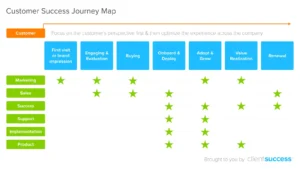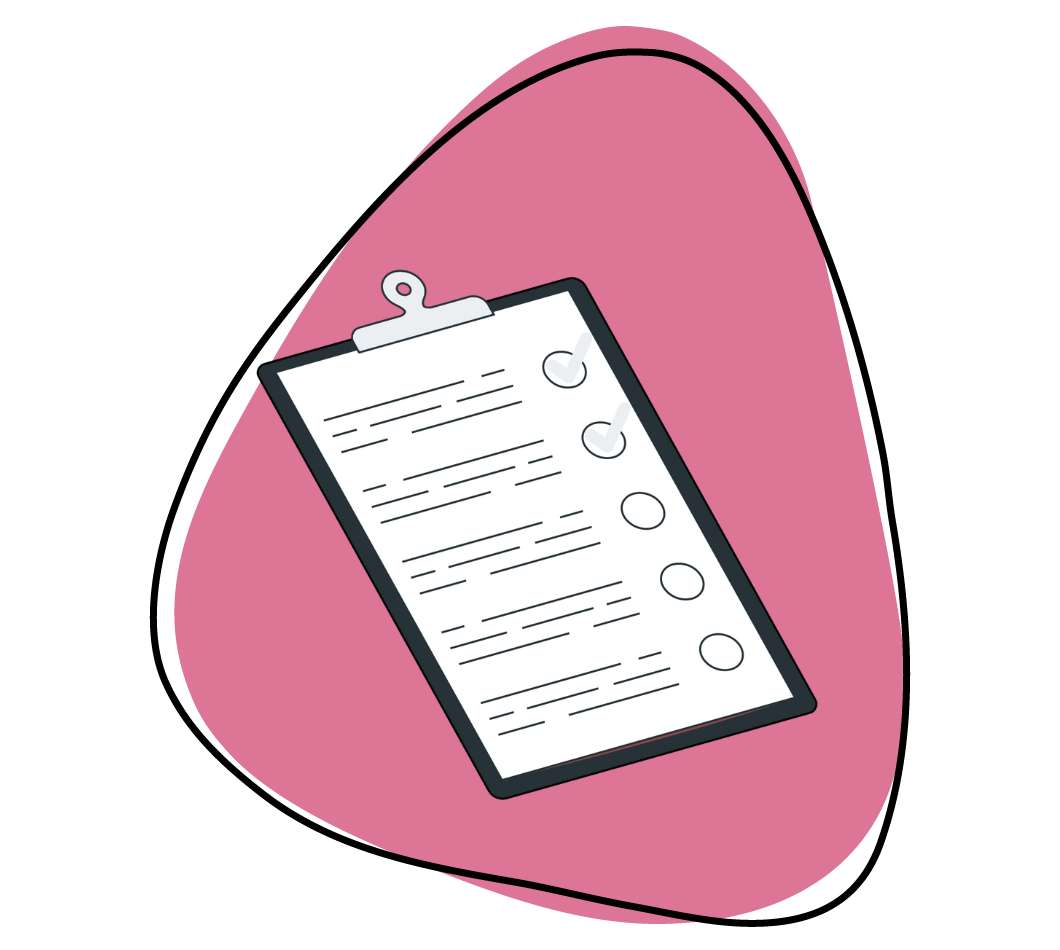Customer success has taken center stage in the past few years. Organizations around the world have realized that by prioritizing customer experience and the success of their customers, they tend to profit more — who’d have thought! But how can your company ensure customer success?
The answer is to create a customer success journey map.
In this article we’ll explain exactly what a customer success journey map is and why it’s important. Then we’ll show you how to make one in five easy steps. Let’s dive in!
What is a Customer Success Journey Map?
To answer that question, we first have to define what “customer success” is. According to HubSpot, customer success is:
“An organizational function that helps customers get maximum value out of a product or service, while working closely with sales, marketing, and product to achieve that goal.”
A customer success journey map, then, is simply a visualization of the journey a customer will go on to achieve success with your company’s products.
For example, an effective map will start with an outline of proper marketing and sales strategies. It will then show how new customers should be onboarded and how they’ll receive value from a company’s products. Finally, the map will move into potential up-sell and cross-sell opportunities and, if applicable, renewal options for customers.
This graphic from Client Success does a great job of illustrating each phase in a typical customer success journey and the departments involved with each:

The Importance of a Customer Success Journey Map
So why are customer success journey maps important? There are two main reasons: they’ll give your company a better understanding of its customers and help it achieve a stronger customer retention rate. Let’s take a look at each of these benefits in more detail:
1. A Better Understanding of Customers
When you create a customer journey map, you’ll be able to see what kind of content connects best with your target market. This will enable you to develop better marketing strategies and sales processes. You’ll also gain insight into the kinds of problems your customers deal with and have the opportunity to solve them before your customers experience them.
2. A Stronger Customer Retention Rate
Your customer success journey map will allow you to provide better experiences to your customers, which in turn, will make your products more valuable to them. Customers that find your products valuable will be much less likely to purchase from your competitors. Because of this, you acquisition costs will go down, company revenue will go up, and your organization’s reputation in the eyes of the general public will skyrocket.
Are Customer Success and Customer Support the Same Thing?
While they are related, customer success and customer support are two different company functions. Customer support is reactive, members of this department aren’t “activated” until a customer contacts them with a complaint. But customer success is proactive. An effective customer success program is designed to anticipate potential problems and provide solutions before customers encounter them.
Can you see the difference? Both company functions are important and necessary but they are not the same and shouldn’t be thought of as such.
Develop a Customer Success Journey Map is 5 Steps
Now that we know what a customer success journey map is, let’s talk about how to create one. There are five steps you need to follow, which we’ve outlined below:
1. Know Your Audience
To accurately map out the journey your customers will take with your company from beginning to end, you have to know your audience. What are they trying to achieve by purchasing your products? What does success look like to them?
If your company has them, we recommend taking a look at its buyer personas to help answer some of these questions. A buyer persona, for those who aren’t familiar with the term, is a fictional character created to represent a subset of a brand’s customer base. Proper buyer personas contain both demographic information (gender, age, occupation, income level, etc.) and psychographic details (hopes, fears, daily challenges, etc.)
If your company’s buyer personas don’t give you all the information you need to craft an effective customer success journey map, you can always survey your current customers. Ask them questions like:
- How did you hear about our company and what convinced you to purchase a product?
- What goal(s) are you trying to accomplish by purchasing our products?
- Have you ever visited our website with the intention of purchasing a product but ultimately decided not to? Why did you make that decision?
When you truly understand your customers and what success looks like to them, you can draft a customer success journey map that will help them achieve their goals as quickly as possible.
2. Identify Each Customer Stage
Next, you need to identify each stage in the lifecycle of your customers. These are the phases each of them goes through on their journey from never having heard of your brand before to becoming raving fans. For many companies, customers go through six phases:
- First Contact: This is when potential customers first hear about your company and the solutions it sells. Marketing is generally the only department involved.
- Evaluation: At this phase, potential customers are evaluating whether your company’s solution is right for them or not. Depending on the size of your organization and the products it sells, both marketing and sales departments may be involved at this time.
- Purchase: You’ve convinced a prospect to become a customer and they’ve decided to purchase your solution. Congrats! Just like before, both marketing and sales may be involved in this phase depending on your organizational structure.
- On-boarding: Once a customer purchases a product, they need to start using it. This is called the on-boarding phase and its generally handled by sales, success, support, or product teams (or a combination of them all).
- Adoption and Growth: Just because a customer has been on-boarded doesn’t mean they’ve adopted your company’s solution and learned how to use it. This is a critical phase. Customers that don’t adopt and grow probably won’t renew and/or purchase additional solutions. This stage of the customer success journey is typically handled by marketing, success, support, and product teams.
- Renewal: Finally, we have renewal. This is when a customer decides to continue doing business with your company or not. If you’ve done your job throughout the first five stages, this should be an easy decision for your customers to make. The renewal phase is often handled by sales and customer success teams.
3. Map Out Your Touch Points
At this point, you know who your customers are and what success looks like to them. You’ve also identified each stage in your customer success journey and the departments associated with each. Now it’s time to map out the various touch points your prospects and customers will interact with.
These include your company’s website, social media channels, email marketing, advertising, downloadable documents, press, and more.
This step is very important. If you don’t know how your prospects and customers interact with your brand, how can you expect to improve their experiences with your company? You can’t. So do your research and learn the touch points your audience meets and the actions they take at each.
4. Dig Into Customer Mindsets
It’s not enough to simply know the touch points your prospects and customers interact with and the actions they take at each one. You also need to understand why they behave this way. What are they thinking and feeling at each touchpoint? What obstacles are they trying to overcome, what pain point are they trying to remedy?
You should also look for roadblocks in your customer journey. What is preventing potential customers from becoming customers? And what’s stopping current customers from purchasing again and again? Cost is often a major reason for these roadblocks but it’s far from the only one. Put on your detective hat and discover what the obstacles are so you can remove them.
5. Optimize for the Future
If you’ve reached this step then your customer success journey map is done. It has the stages that apply to you and your customers and the departments that are associated with each. It includes every potential touchpoint as well as the mindset your audience has when they interact with them. You’ve even dug deeper and discovered why a prospect might react to a specific touchpoint in a certain way and decide not to purchase from your company.
Good work, your customer success journey map is complete — but it’s not finished! And it will never really be finished because your audience will change, new touchstones will become available to them, and your company will start to offer new solutions. Which means you need to stay vigilant and optimize your map as needed.
Look for ways to enhance your customer experience and help your audience achieve greater success with your products. At the same time, identify the tactics and strategies that are working well for your company and double down on them.
The Customer Success Tools You Need
A customer success journey map will tell you how to provide better brand experiences for your prospects and customers. But it can’t actually help you put a plan into action. For that, you need to use other tools. Here are the best customer success solutions available.
1. Gainsight
Gainsight creates software to help companies “increase revenue, decrease customer churn, and drive advocacy.” It features data-driven reports and productivity tools to help its users better understand their target market and respond to their needs quicker. It really works too! That’s why mega brands like Adobe, GE, and Dell use the tool.
If you’re looking to easily create and maintain a customer success journey map, Gainsight is an excellent solution.
2. HubSpot
While HubSpot probably isn’t the first brand that comes to mind when you think “customer success tools,” the company did unveil a brand new customer service platform recently. This software makes it easy to connect with customers and help them succeed with features like the Conversations inbox, which brings together all of your company’s communication channels — email, live chat, Facebook Messenger, etc. — into one centralized platform.
It also has reporting options so that you can learn about your customer base on a deeper level. All in all, it’s a solid tool, especially for organizations that already use the HubSpot solution for marketing and sales purposes.
3. Zight (formerly CloudApp)
Lastly, we have Zight (formerly CloudApp). Unlike the two tools already mentioned, Zight (formerly CloudApp) is not a one stop shop for customer success. It won’t give you detailed insights into your audience or combine all of your customer emails into one central inbox. What is does, though, is pretty awesome!
Zight (formerly CloudApp) is visual communication done right. It features a screen recorder, GIF creator, and video annotation capabilities which allow customer success teams to quickly communicate with customers in clear, concise ways. In fact, Gainsight, the full-stop customer success platform mentioned earlier, uses Zight (formerly CloudApp) every day to improve its customer success efforts!
Give Zight (formerly CloudApp) a try for FREE today!
Your Turn: Map Your Customer Success Journey
A customer success journey map will enable your business to better understand its customers, provide them with better experiences, and boost its retention rate. Fortunately, crafting one is a pretty straightforward process! Just follow the five steps we outlined in this article:
- Know Your Audience
- Identify Each Customer Stage
- Map Out Your Touchpoints
- Dig Into Customer Mindsets, and
- Optimize for the Future
And don’t forget to try Zight (formerly CloudApp) for free today! Our screen recording, GIF creation, and image annotation features will let you communicate with customers quickly and clearly and succeed at customer success.












